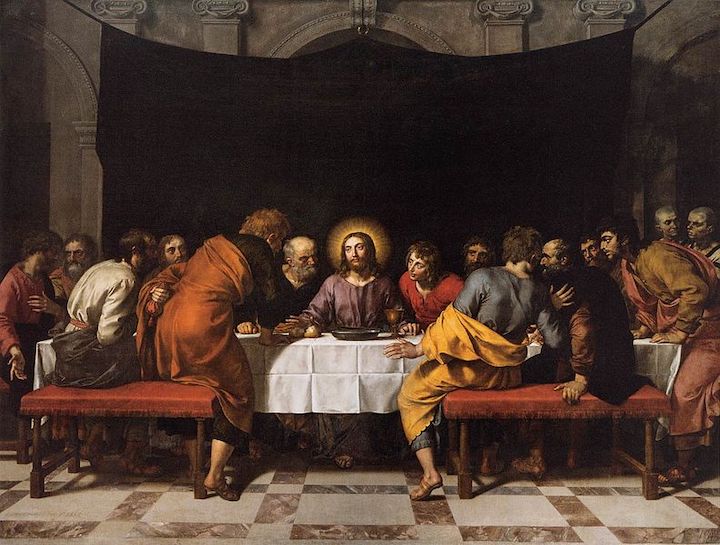St. John’s account of the Passion begins by drawing us into the mind and heart of Jesus: “[He] knew that his hour had come to pass from this world to the Father. He loved his own in the world and he loved them to the end.”
Jesus is God the Son, sent by the Father to accomplish the Trinity’s eternal plan of wedding humanity to Himself despite our sinful betrayals. (Is. 62:5) To begin this reconciliation, He united our nature to Himself in the Incarnation.
That “hypostatic” union means Christ, in body and soul, participates in the life of the Trinity as the perfect expression of the Person of the Word. So it is that Jesus is able to know and love all of “His own in the world,” embracing not only those living in his time, but the dead and those yet to be born. Through this new, personal relation He makes us one with God .
The key to the Redemption is that Christ chose to be lifted up on the Cross in order to draw us to Himself, even as a husband clings to his wife (Jn 12:32; Eph 5:31-32), not merely to forgive our sins. He weds us to Himself as members of his Bride, the Church, so we might share in His life and saving mission on earth and attain fullness of life in the Wedding Feast of Heaven. In that celebration, He will perfectly unite “His own” to the Trinity, and each other, forever.
Once we recognize the nuptial union that Jesus establishes with the Church, we can begin to appreciate how He brings us into the saving Passover that begins at the Last Supper, and is fulfilled through His death, resurrection, and ascension to glory.
On the night he was betrayed, Christ simultaneously reveals the gift of Himself and a summons to share in His sacrificial love of God and neighbor. Calling His disciples “friends,” He declares, “No one has greater love than this, to lay down one’s life for one’s friends.”
As He prays over the bread and wine, He reveals the body and blood taken up in the Incarnation to be the means of expressing and realizing personal communion with His friends. They are all one with him in the perfect sacrifice He offers to the Father.
He tells the disciples to eat His Body, which will be given up for them, and to drink His Blood, which will be poured out for them. Notice that He gives Himself both to them and for them.
By enjoining them to “do this in memory of me,” Jesus isn’t only insisting they celebrate Mass as a memorial sacrifice. He’s calling them to do as He does, namely, to give themselves to Him and to lay down their lives for Him. It’s the same summons to self-sacrificing service He issued after washing their feet: “As I have done for you, you should also do.”

The nuptial character and intimacy of the union Christ established in the New Covenant is evident in consuming His Body and Blood. Other than the conjugal act, it would be hard to find a more vivid means of symbolizing and effecting a complete personal union, in body and soul.
Through the act of Holy Communion, Jesus reveals that the disciples are now members of His Body and Bride, the Church. Simultaneously, he reveals himself as Head and Bridegroom. This means they’ve become part of the sacrifice He will offer on the Cross.
Just as Eve was fashioned to be a suitable helpmate to Adam, so the Church is being fashioned as the spouse of the New Adam. He, of course, is our Savior and Head, the vine apart from whom we have no new life and can bear no fruit. But he has chosen to make us his handiwork and coworkers in the plan of salvation.
Thus made one with Jesus, we are united to the Trinity and become a pleasing sacrifice of love. The whole of our existence as Christians is the living out of that sacrificial love in and with him. This glorifies God, transforms us, and contributes to the transformation of the whole human race.
Of course, at the Last Supper, the Apostles didn’t entirely understand Jesus’ words and actions. They all fled when he was arrested and only John stayed close to Him at the end. Their sinful weakness was tragic, but Jesus never abandoned them – or us.
Christ knew and loved His own – including us – “to the very end.” He drew everyone to Himself on the Cross, so that we might be offered with Him to the Father.
We miss the heart of the Last Supper – and of the entire mystery of salvation – if we stop at the foot of the Cross or consider it only in terms of the forgiveness of sin. Jesus gives Himself to his disciples so that we we can join him on the Cross and share his sacrificial love for God and neighbor. That’s why His New Commandment is to love as he loves.
We’re not mere spectators or recipients of His saving work. We’re participants and cooperators. Like Mary, our hearts must be pierced for love of Him who first loved us. They’re pierced because, united to Jesus, they overflow with His joys and sorrows.
As we enter the Sacred Triduum tonight with the Mass of the Lord’s Supper, indeed, as we live Christian life daily and participate in any Mass, let us consider Jesus’ sacrificial gift of Himself. By this gift, He cleanses us from sin, draws us to Himself, and enables us to pour ourselves out with Him in loving service to God and neighbor.
That’s how His sacrifice and Passover become ours.
*Image: The Last Supper (La Sainte Cène) by Frans Pourbus the Younger, 1618 [Louvre, Paris]
You may also enjoy:
Michael Pakaluk’s Giving Others a Reason to Be Christian
Fr. Thomas G. Weinandy’s The Pandemic and Repentance















